-
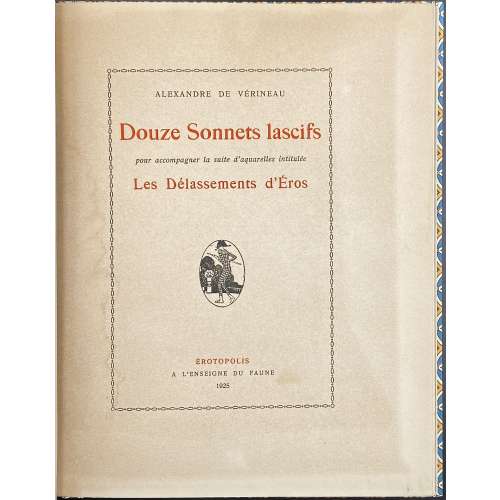 Volume bound by Boichot (signed on front pastedown), 25.3 x 20.2 cm in a 25.9 x 20.3 slipcase, the book and the case uniformly in beige, brown, and blue diaper paper with a navy blue label with gilt lettering to book's spine, top edge gilt, J.-P. Dutel’s bookplate to fep, portfolio cover preserved. Pp.: [1-4] 5-37 [38 blank]; collated 4to, 13 2-54; total 19 leaves (38 pages), plus 12 plates coloured in stencil technique (pochoir), produced after watercolours by Gerda Wegener in c. 1917 on Arches or Whatman laid paper, watermarked. Each illustration bears a small masquerade mask at the bottom as a signature. Text printed on laid paper without a watermark; starting from 2nd gathering, the text printed on recto only; minor traces of water stain to some pages. Title-page (red and black): ALEXANDRE DE VÉRINEAU | Douze Sonnets lascifs | pour accompagner la suite d’aquarelles intitulée | Les Délassements d’Éros | {vignette medallion} | ÉROTOPOLIS | A L’ENSEIGNE DU FAUNE | 1925 || First edition, first printing (incl. plates); clandestine. Catalogue raisonné: Dutel 1356, 1434; Pia 363/4; Noedmann I 310; Fekete 221. Contributors: Louis Perceau (French, 1883 – 1942) – author (see LIB-2633.2021: Guillaume Apollinaire, Fernand Fleuret, Louis Perceau. L'enfer de la Bibliothèque Nationale. — Paris: Mercure de France, 1913). Gerda Wegener (Danish, 1886 – 1940) – artist. Maurice Duflou (French, 1885 – 1951) – publisher. Boichot – bookbinder.
Volume bound by Boichot (signed on front pastedown), 25.3 x 20.2 cm in a 25.9 x 20.3 slipcase, the book and the case uniformly in beige, brown, and blue diaper paper with a navy blue label with gilt lettering to book's spine, top edge gilt, J.-P. Dutel’s bookplate to fep, portfolio cover preserved. Pp.: [1-4] 5-37 [38 blank]; collated 4to, 13 2-54; total 19 leaves (38 pages), plus 12 plates coloured in stencil technique (pochoir), produced after watercolours by Gerda Wegener in c. 1917 on Arches or Whatman laid paper, watermarked. Each illustration bears a small masquerade mask at the bottom as a signature. Text printed on laid paper without a watermark; starting from 2nd gathering, the text printed on recto only; minor traces of water stain to some pages. Title-page (red and black): ALEXANDRE DE VÉRINEAU | Douze Sonnets lascifs | pour accompagner la suite d’aquarelles intitulée | Les Délassements d’Éros | {vignette medallion} | ÉROTOPOLIS | A L’ENSEIGNE DU FAUNE | 1925 || First edition, first printing (incl. plates); clandestine. Catalogue raisonné: Dutel 1356, 1434; Pia 363/4; Noedmann I 310; Fekete 221. Contributors: Louis Perceau (French, 1883 – 1942) – author (see LIB-2633.2021: Guillaume Apollinaire, Fernand Fleuret, Louis Perceau. L'enfer de la Bibliothèque Nationale. — Paris: Mercure de France, 1913). Gerda Wegener (Danish, 1886 – 1940) – artist. Maurice Duflou (French, 1885 – 1951) – publisher. Boichot – bookbinder. -
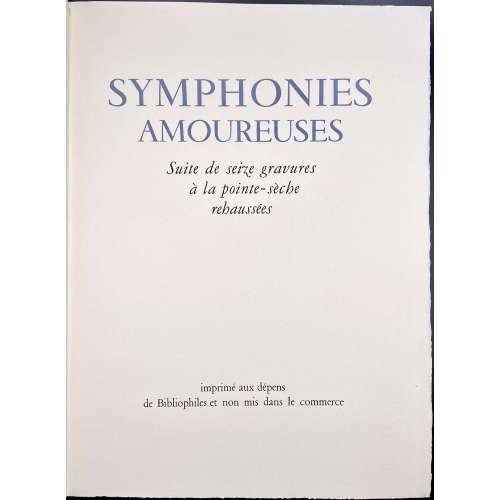 Description: Suite of 16 hand-coloured drypoints, in 39 x 29 cm, in cream French flapped wrappers with lavender lettering “SYMPHONIES AMOUREUSES” and a sanguine drypoint vignette (platemark 15 x 13 cm) to front, 17 leaves plus 2 leaves in the wrappers, 38.5 x 57 cm vertically folded once, lettering to one page, plate to another page, unbound, only the top margin trimmed, unpaginated, wove paper watermarked "BFK Rives", in a faux chagrin double slipcase 39.8 x 30 cm. Title-page (in lavender and black): SYMPHONIES AMOUREUSES | Suite de seize gravures | à la pointe sèche | rehaussées | {blank} | imprimé aux dépens | de Bibliophiles et non mis dans le commerce || Titles of the plates : 1. Ouverture. 2. Gamme. 3. Rêverie. 4. Pas redoublé. 5 Fantasia. 6. Pastorale. 7. Estudiantina. 8. Presto. 9. Arpège. 10. Menuet. 11 .Symphonie médiévale. 12. Jeux d’eau. 13. Galop. 14. Impromptu. 15. Variation. 16. Ariette. Limitation: Print run of 100 copies, 5 copies on Japon Manchou, numbered №№ 1-5, enriched; 11 copies on vélin à la forme de Rives, numbered №№ 6-16, enriched; 84 copies on vélin à la forme de Rives, numbered №№ 17-100, of which this is copy № 32. Cat. raisonné: Dutel III, № 2478. Contributors: André Collot (French, 1897 – 1976) – artist, engraver.
Description: Suite of 16 hand-coloured drypoints, in 39 x 29 cm, in cream French flapped wrappers with lavender lettering “SYMPHONIES AMOUREUSES” and a sanguine drypoint vignette (platemark 15 x 13 cm) to front, 17 leaves plus 2 leaves in the wrappers, 38.5 x 57 cm vertically folded once, lettering to one page, plate to another page, unbound, only the top margin trimmed, unpaginated, wove paper watermarked "BFK Rives", in a faux chagrin double slipcase 39.8 x 30 cm. Title-page (in lavender and black): SYMPHONIES AMOUREUSES | Suite de seize gravures | à la pointe sèche | rehaussées | {blank} | imprimé aux dépens | de Bibliophiles et non mis dans le commerce || Titles of the plates : 1. Ouverture. 2. Gamme. 3. Rêverie. 4. Pas redoublé. 5 Fantasia. 6. Pastorale. 7. Estudiantina. 8. Presto. 9. Arpège. 10. Menuet. 11 .Symphonie médiévale. 12. Jeux d’eau. 13. Galop. 14. Impromptu. 15. Variation. 16. Ariette. Limitation: Print run of 100 copies, 5 copies on Japon Manchou, numbered №№ 1-5, enriched; 11 copies on vélin à la forme de Rives, numbered №№ 6-16, enriched; 84 copies on vélin à la forme de Rives, numbered №№ 17-100, of which this is copy № 32. Cat. raisonné: Dutel III, № 2478. Contributors: André Collot (French, 1897 – 1976) – artist, engraver. -
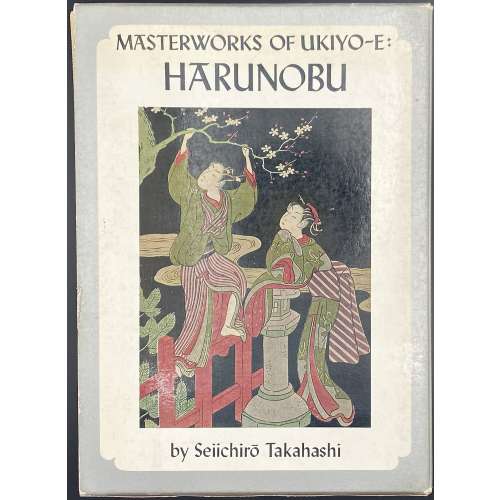 Hardcover volume from the series Masterworks of ukiyo-e, 26.5 x 19.1 cm, bound in unprimed canvas, red characters on black strip to front 春信, red and black lettering to spine, cream embossed endpapers, in a pictorial slipcase with series design (black lettering on silver spine); pp: [1-6]: h.t./frontis. (colour plate pasted in), t.p./imprint, contents/blank), 7-30 text, [2] faux-title, 33-96 (66 colour plates w/captions). Title-page (in frame): MASTERWORKS OF UKIYO-E | HARUNOBU | by Seiichirō Takahashi | English adaptation by John Bester | {publisher’s device} | KODANSHA INTERNATIONAL LTD. | Tokyo, Japan & Palo-Alto, Calif., U.S.A | {vertical, between rules 春信} || Series: Masterworks of ukiyo-e, № 6. Contributors: Seiichirō Takahashi [高橋誠一郎] (Japanese, 1884 – 1982) – author. Suzuki Harunobu [鈴木 春信] (Japanese, 1725 – 1770) – artist. John Bester (British, 1927 – 2010) – adaptation.
Hardcover volume from the series Masterworks of ukiyo-e, 26.5 x 19.1 cm, bound in unprimed canvas, red characters on black strip to front 春信, red and black lettering to spine, cream embossed endpapers, in a pictorial slipcase with series design (black lettering on silver spine); pp: [1-6]: h.t./frontis. (colour plate pasted in), t.p./imprint, contents/blank), 7-30 text, [2] faux-title, 33-96 (66 colour plates w/captions). Title-page (in frame): MASTERWORKS OF UKIYO-E | HARUNOBU | by Seiichirō Takahashi | English adaptation by John Bester | {publisher’s device} | KODANSHA INTERNATIONAL LTD. | Tokyo, Japan & Palo-Alto, Calif., U.S.A | {vertical, between rules 春信} || Series: Masterworks of ukiyo-e, № 6. Contributors: Seiichirō Takahashi [高橋誠一郎] (Japanese, 1884 – 1982) – author. Suzuki Harunobu [鈴木 春信] (Japanese, 1725 – 1770) – artist. John Bester (British, 1927 – 2010) – adaptation. -
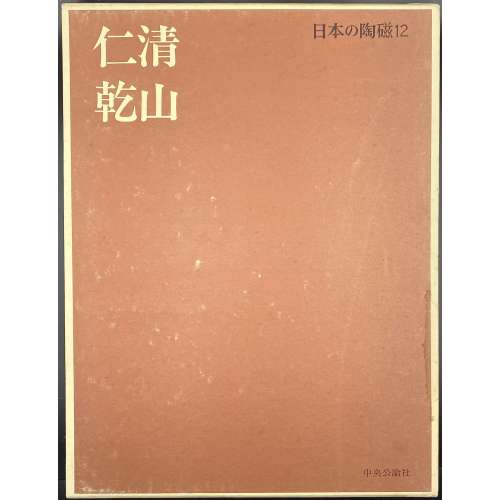 Hardcover volume, 35 x 27 cm, bound in grey cloth, blind stamped characters to front, brown characters to spine, in a slipcase, the outer case missing, pp.: [4] [1] 2-116 (plates with photographs of 202 items), [2] 119-154 [4]. Ninsei [仁清] and Kenzan [乾山] ceramics produced by Ninsei Nonomura [野々村仁清] (Japanese, c. 1640 – c. 1690) and Ogata Kenzan [尾形 乾山] (Japanese, 1663 – 1743), respectively. 日本の陶磁 – Japanese ceramics, series title. Contributors: Yasunari Kawabata [川端 康成] (Japanese, 1924 – 1972) – author. Tetsuzo Tanikawa [谷川 徹三] (Japanese, 1895 – 1989) – author. Seizo Hayashiya [林屋晴三] (Japanese, 1928 – 2017) – editor. Chūōkōron-sha [中央公論社] – publisher.
Hardcover volume, 35 x 27 cm, bound in grey cloth, blind stamped characters to front, brown characters to spine, in a slipcase, the outer case missing, pp.: [4] [1] 2-116 (plates with photographs of 202 items), [2] 119-154 [4]. Ninsei [仁清] and Kenzan [乾山] ceramics produced by Ninsei Nonomura [野々村仁清] (Japanese, c. 1640 – c. 1690) and Ogata Kenzan [尾形 乾山] (Japanese, 1663 – 1743), respectively. 日本の陶磁 – Japanese ceramics, series title. Contributors: Yasunari Kawabata [川端 康成] (Japanese, 1924 – 1972) – author. Tetsuzo Tanikawa [谷川 徹三] (Japanese, 1895 – 1989) – author. Seizo Hayashiya [林屋晴三] (Japanese, 1928 – 2017) – editor. Chūōkōron-sha [中央公論社] – publisher. -
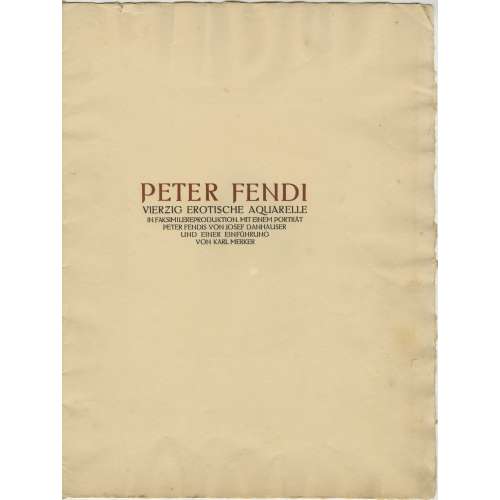 Six in-folio leaves, 2o, incl. title-page, engraved portrait of P. Fendi after Josef Danhauser, 4 pages of printed text, and 10 of 40 colour photomechanical reproductions of Fendi’s watercolour plates (205 x 140 mm), mounted on vellum paper with blind stamp (398 x 305 mm) in a parchment-backed flapped album (defective), gilt-stamped, with straps. Limited edition of 600 copies. The publisher is not stated but is sometimes attributed to C. W. Stern in Vienna. Limitation statement and imprint missing. Title-page (brown and black): PETER FENDI | VIERZIG EROTISCHE AQUARELLE | IN FAKSIMILEREPRODUKTION. MIT EINEM PORTRÄT | PETER FENDIS VON JOSEF DANHAUSER | UND EINER EINFÜHRUNG | VON KARL MERKER || Catalogue Raisonné: Nordmann II № 198, p.96. Contributors: Peter Fendi (Austrian, 1796 – 1842) Josef Danhauser (Austian, 1805 – 1845) Karl Merker – author/introduction.
Six in-folio leaves, 2o, incl. title-page, engraved portrait of P. Fendi after Josef Danhauser, 4 pages of printed text, and 10 of 40 colour photomechanical reproductions of Fendi’s watercolour plates (205 x 140 mm), mounted on vellum paper with blind stamp (398 x 305 mm) in a parchment-backed flapped album (defective), gilt-stamped, with straps. Limited edition of 600 copies. The publisher is not stated but is sometimes attributed to C. W. Stern in Vienna. Limitation statement and imprint missing. Title-page (brown and black): PETER FENDI | VIERZIG EROTISCHE AQUARELLE | IN FAKSIMILEREPRODUKTION. MIT EINEM PORTRÄT | PETER FENDIS VON JOSEF DANHAUSER | UND EINER EINFÜHRUNG | VON KARL MERKER || Catalogue Raisonné: Nordmann II № 198, p.96. Contributors: Peter Fendi (Austrian, 1796 – 1842) Josef Danhauser (Austian, 1805 – 1845) Karl Merker – author/introduction. -
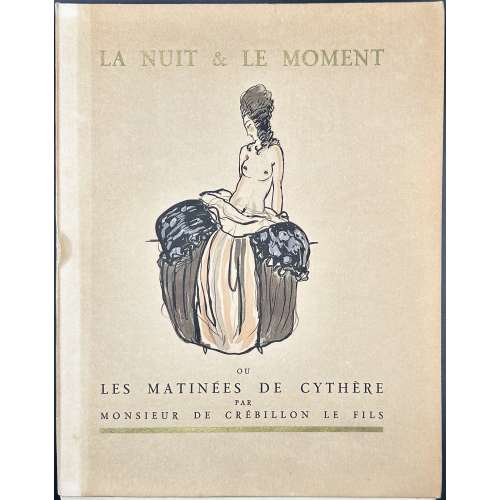 Softcover volume, 33 x 26 cm, collated in folio, not bound, in publisher’s French flapped pictorial wrappers, lettering to spine; printed on thick wove Arches paper watermarked “MBM”, upper edge trimmed, owner’s blind stamp to h.t. “Ex Libris Comte Tony de Vibraye”, glassine dust jacket, in a slipcase. Collation: π2 1-262, total 54 leaves, plus 4 leaves in wrappers, plus 10 plates, incl. frontispiece; coloured aquatints after Sylvain Sauvage; coloured etched vignette to front wrapper, gilt woodcut to back wrapper, woodcut title-page and woodcut headpiece after the same. Pp.: [4] [1] 2-102 [2]. Front wrapper (gilt and black): LA NUIT & LE MOMENT | {vignette} | OU | LES MATINÉES DE CYTHÈRE | PAR | MONSIEUR DE CRÉBILLON LE FILS | — || Title-page (woodcut): CRÉBILLON LE FILS | — | LA NUIT ET LE MOMENT | OU | LES MATINÉES | DE CYTHÈRE | {vignette} | A PARIS | AUX DEPENS D'UN AMATEUR | — | M CM XXIV || Limitation: De cette édition il a été tiré un exemplaire unique sur japon impérial comportant dix aquarelles originales, deux cents trente exemplaires sur vélin d' Arches numérotés 1 à 230, dont les dix premiers avec une suite de hors texte sur japon. N° 1 [Print run limited to 230 copies on Arches plus a unique copy on Japon with original watercolours, this is copy № 1 on wove paper]. Seller’s description: La Nuit et le moment ou Les Matinées de Cythère. Paris, Au dépens d'un amateur, 1924. In-4, en feuilles, non rogné, couverture illustrée et étui. Ouvrage illustré de 4 gravures sur bois et de 10 eaux-fortes libres en couleurs hors texte de Sylvain Sauvage. Tirage à 231 exemplaires, celui-ci le n°1 sur vélin d'Arches. Manque la suite de hors texte sur japon. De la bibliothèque du Comte Tony de Vibraye, avec cachet à froid. Dutel, n°2062. Catalogue raisonné: honesterotica.com; Dutel III 2062. Contributors: Claude-Prosper Jolyot de Crébillon [Crébillon fils] (French, 1707 – 1777) – author. Sylvain Sauvage [Félix Roy] (French, 1888 – 1948) – artist. Provenance: Antoine Henri Gaston Hurault de Vibraye [Comte Tony de Vibraye] (French, 1893 – 1951)
Softcover volume, 33 x 26 cm, collated in folio, not bound, in publisher’s French flapped pictorial wrappers, lettering to spine; printed on thick wove Arches paper watermarked “MBM”, upper edge trimmed, owner’s blind stamp to h.t. “Ex Libris Comte Tony de Vibraye”, glassine dust jacket, in a slipcase. Collation: π2 1-262, total 54 leaves, plus 4 leaves in wrappers, plus 10 plates, incl. frontispiece; coloured aquatints after Sylvain Sauvage; coloured etched vignette to front wrapper, gilt woodcut to back wrapper, woodcut title-page and woodcut headpiece after the same. Pp.: [4] [1] 2-102 [2]. Front wrapper (gilt and black): LA NUIT & LE MOMENT | {vignette} | OU | LES MATINÉES DE CYTHÈRE | PAR | MONSIEUR DE CRÉBILLON LE FILS | — || Title-page (woodcut): CRÉBILLON LE FILS | — | LA NUIT ET LE MOMENT | OU | LES MATINÉES | DE CYTHÈRE | {vignette} | A PARIS | AUX DEPENS D'UN AMATEUR | — | M CM XXIV || Limitation: De cette édition il a été tiré un exemplaire unique sur japon impérial comportant dix aquarelles originales, deux cents trente exemplaires sur vélin d' Arches numérotés 1 à 230, dont les dix premiers avec une suite de hors texte sur japon. N° 1 [Print run limited to 230 copies on Arches plus a unique copy on Japon with original watercolours, this is copy № 1 on wove paper]. Seller’s description: La Nuit et le moment ou Les Matinées de Cythère. Paris, Au dépens d'un amateur, 1924. In-4, en feuilles, non rogné, couverture illustrée et étui. Ouvrage illustré de 4 gravures sur bois et de 10 eaux-fortes libres en couleurs hors texte de Sylvain Sauvage. Tirage à 231 exemplaires, celui-ci le n°1 sur vélin d'Arches. Manque la suite de hors texte sur japon. De la bibliothèque du Comte Tony de Vibraye, avec cachet à froid. Dutel, n°2062. Catalogue raisonné: honesterotica.com; Dutel III 2062. Contributors: Claude-Prosper Jolyot de Crébillon [Crébillon fils] (French, 1707 – 1777) – author. Sylvain Sauvage [Félix Roy] (French, 1888 – 1948) – artist. Provenance: Antoine Henri Gaston Hurault de Vibraye [Comte Tony de Vibraye] (French, 1893 – 1951) -
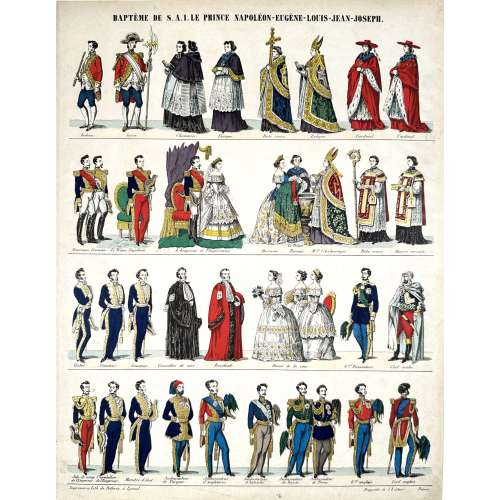 Hand-coloured woodcut on wove paper, 460 x 363 mm; black ink stamp “5054” to reverse. Four tiers with groups of people dressed in uniform, captioned: Bedeau — Suisse — Chanoines — Évêque — Porte croix — Évêque — Cardinal — Cardinal | Généraux français — Le prince Napoléon — L’Empereur et l’Impératrice — Marraine — Le Prince — Parrain | Meur l’Archevêque | Porte crosse Diacre servant | Préfet — Sénateur — Conseiller de cour — Président — Dames de la cour — Gral Piémontais — Chef arabe | Aide-de-camp de l’Empereur — Chambellan de l’Empereur — Ministre d’état — Ambassadeur de Turque | Ambassadeur d’Angleterre — Ambassadeur d’Autriche — Ambassadeur de Russie — Ambassadeur de Prusse — Gral anglaise — Lord anglais || Bottom left: Imprimerie Lith. de Pellerin, à Épinal; right: Propriété de l’Éditeur. — Déposé. Jean Charles Pellerin (French, 1756 – 1836) – printer/publisher.
Hand-coloured woodcut on wove paper, 460 x 363 mm; black ink stamp “5054” to reverse. Four tiers with groups of people dressed in uniform, captioned: Bedeau — Suisse — Chanoines — Évêque — Porte croix — Évêque — Cardinal — Cardinal | Généraux français — Le prince Napoléon — L’Empereur et l’Impératrice — Marraine — Le Prince — Parrain | Meur l’Archevêque | Porte crosse Diacre servant | Préfet — Sénateur — Conseiller de cour — Président — Dames de la cour — Gral Piémontais — Chef arabe | Aide-de-camp de l’Empereur — Chambellan de l’Empereur — Ministre d’état — Ambassadeur de Turque | Ambassadeur d’Angleterre — Ambassadeur d’Autriche — Ambassadeur de Russie — Ambassadeur de Prusse — Gral anglaise — Lord anglais || Bottom left: Imprimerie Lith. de Pellerin, à Épinal; right: Propriété de l’Éditeur. — Déposé. Jean Charles Pellerin (French, 1756 – 1836) – printer/publisher. -
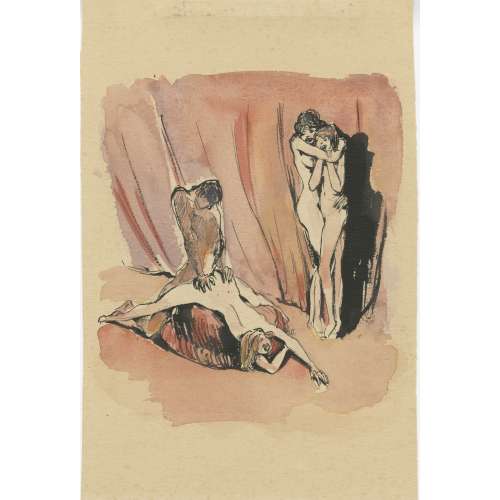 Watercolour on wove paper, 243 x 161 mm, black ink stamp to verso: “Nachlaß O R SCHATS”. Attributed to Otto Rudolf Schatz (Austrian, 1900 – 1961).
Watercolour on wove paper, 243 x 161 mm, black ink stamp to verso: “Nachlaß O R SCHATS”. Attributed to Otto Rudolf Schatz (Austrian, 1900 – 1961). -
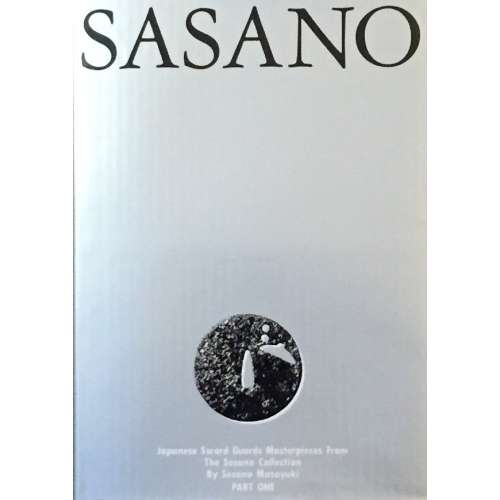
Sasano: Japanese Sword Guard Masterpieces from the Sasano Collection. By Sasano Masayuki. Part One. Published in Japan in 1994 by Daisuke Saito, Mega Co., Ltd. Translated by Tomoko Saro. Printed by Mitsumura Printing Co., Ltd. 304 x 217 x 30 mm
-
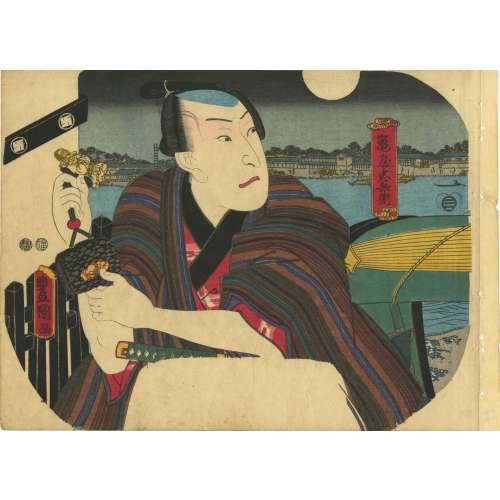 Artist: Utagawa Kunisada [歌川 国貞] a.k.a. Utagawa Toyokuni III [三代歌川豊国] (Japanese, 1786 – 1865). Signed: Toyokuni ga [豊国 画] in a red toshidama cartouche. Actor: Sawamura Gennosuke II [沢村源之助] (Japanese, 1802/7 – 1853); other names: Suketakaya Takasuke III, Sawamura Chōjūrō V [沢村長十郎], Sawamura Tosshō I, Sawamura Genpei I. Character: Kameya Chubei [亀屋忠兵衛] Play: Koi Bikyaku Yamato Orai [恋飛脚大和往来] Performance: Kawarasaki Theatre [河原崎座] in the 2nd month of 1851. Double nanushi censor seals: Fuku & Muramatsu, from 3rd month of Kaei 2 to 11th month of Kaei 4 (1849-51). Another fan print from the pair SVJP-0212-1.2016: Ichikawa Ebizō V as Tanbaya Onizo / Fan print, 1851.
Artist: Utagawa Kunisada [歌川 国貞] a.k.a. Utagawa Toyokuni III [三代歌川豊国] (Japanese, 1786 – 1865). Signed: Toyokuni ga [豊国 画] in a red toshidama cartouche. Actor: Sawamura Gennosuke II [沢村源之助] (Japanese, 1802/7 – 1853); other names: Suketakaya Takasuke III, Sawamura Chōjūrō V [沢村長十郎], Sawamura Tosshō I, Sawamura Genpei I. Character: Kameya Chubei [亀屋忠兵衛] Play: Koi Bikyaku Yamato Orai [恋飛脚大和往来] Performance: Kawarasaki Theatre [河原崎座] in the 2nd month of 1851. Double nanushi censor seals: Fuku & Muramatsu, from 3rd month of Kaei 2 to 11th month of Kaei 4 (1849-51). Another fan print from the pair SVJP-0212-1.2016: Ichikawa Ebizō V as Tanbaya Onizo / Fan print, 1851.
-
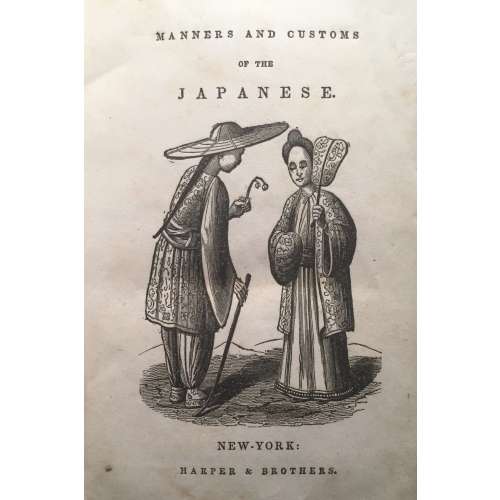
Manners and Customs of the Japanese, in the Nineteenth Century. From the Accounts of Recent Dutch Residents in Japan, and from the German Work of Dr. Ph. Fr. von Siebold.
Author: Siebold, Philipp Franz von et al.
Publisher: Harper & Brothers, New York, 1841.
-
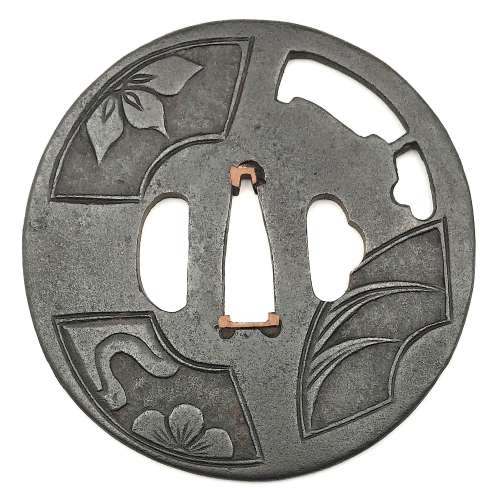 Iron tsuba of round form with design of hatchet executed in openwork (sukashi) and three fan panels motif on both sides carved in low relief (sukidashi-bori). Designs on the fan panels - face: bellflower, plum blossom in mist, grass leaves; - back: clouds, grass, and half plum blossom in mist. Copper sekigane. Koga-hitsu-ana probably cut out on a later date. Kamakura or kamakura-bori school. Edo period. Height: 83.8 mm, Width: 82.2 mm, Thickness at seppa-dai: 3.2 mm. NBTHK certificate № 4005500: Hozon (worthy of preservation).
Iron tsuba of round form with design of hatchet executed in openwork (sukashi) and three fan panels motif on both sides carved in low relief (sukidashi-bori). Designs on the fan panels - face: bellflower, plum blossom in mist, grass leaves; - back: clouds, grass, and half plum blossom in mist. Copper sekigane. Koga-hitsu-ana probably cut out on a later date. Kamakura or kamakura-bori school. Edo period. Height: 83.8 mm, Width: 82.2 mm, Thickness at seppa-dai: 3.2 mm. NBTHK certificate № 4005500: Hozon (worthy of preservation). -
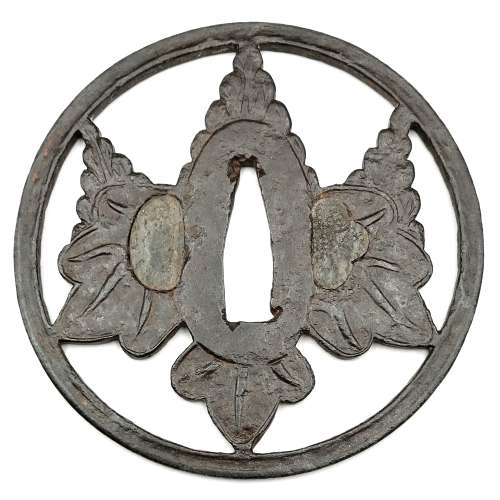 Iron tsuba of round form pierced with design of paulownia (kiri) in a circle in positive silhouette (ji-sukashi), details carved in low relief (sukidashi-bori). Hitsu-ana were cut later and then both plugged with lead or pewter. Brown patina. The most unusual characteristic of this tsuba is its 'positiveness': the absolute majority of Kamakura-bori tsuba are of ko-sukashi type, i.e. with small openings, presenting the motif in negative silhouette. Kamakura-bori school. Muromachi period (ca. 1450). Size: Height: 85.1 mm, width: 84.8 mm, thickness at seppa-dai: 3.2 mm, at rim: 2.8 mm. Weight: 79.1 g. A similar tsuba is presented at Japanese Swords and Sword Fittings from the Collection of Dr. Walter Ames Compton. Part I. Christie's, New York, March 31, 1992, page 11, №3: "A Kamakura-bori tsuba. Muromachi period, ca. 1450. The round iron plate is pierced with an openwork design of a paulownia crest (kiri-mon), the surface details of which are carved in low relief. The design is repeated on the reverse. The edge is slightly raised and the rim has some iron bones. 78 mm x 77 mm x 3.5 mm. Hakogaki by Sato Kanzan, dated summer 1973."
Iron tsuba of round form pierced with design of paulownia (kiri) in a circle in positive silhouette (ji-sukashi), details carved in low relief (sukidashi-bori). Hitsu-ana were cut later and then both plugged with lead or pewter. Brown patina. The most unusual characteristic of this tsuba is its 'positiveness': the absolute majority of Kamakura-bori tsuba are of ko-sukashi type, i.e. with small openings, presenting the motif in negative silhouette. Kamakura-bori school. Muromachi period (ca. 1450). Size: Height: 85.1 mm, width: 84.8 mm, thickness at seppa-dai: 3.2 mm, at rim: 2.8 mm. Weight: 79.1 g. A similar tsuba is presented at Japanese Swords and Sword Fittings from the Collection of Dr. Walter Ames Compton. Part I. Christie's, New York, March 31, 1992, page 11, №3: "A Kamakura-bori tsuba. Muromachi period, ca. 1450. The round iron plate is pierced with an openwork design of a paulownia crest (kiri-mon), the surface details of which are carved in low relief. The design is repeated on the reverse. The edge is slightly raised and the rim has some iron bones. 78 mm x 77 mm x 3.5 mm. Hakogaki by Sato Kanzan, dated summer 1973."
Compton's Collection, Part I, p. 11, №3.
-
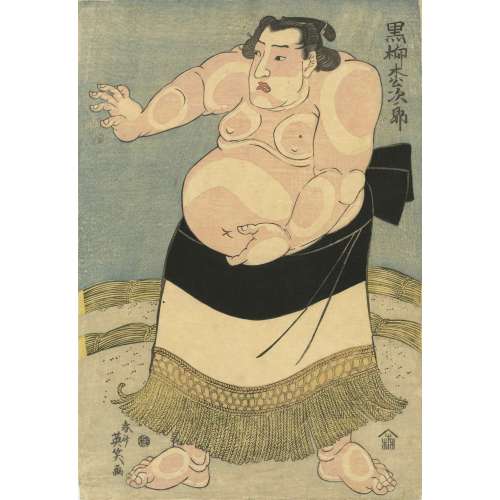 This print was sold to me with the following description: "Ikkansai EISHO (Fl. early 19th c.). A portrait of the wrestler Kuroyanagi Matsujiro, ring name Kumagatake Inosuke. Eisho was a pupil of Eishi. Published c. 1820s by Uoya Eikichi. Signed Shunsai Eisho ga." As a result of our joint effort with my beloved sister, we have so far found the following: The artis is mentioned in The Hotei Encyclopedia of Japanese Woodblock Prints, 2005, Vol 2; p. 438 under the name of Harukawa Eichō. From this source we learned that the artist was active from about 1818 till 1844, and was a print designer in Kyoto. He was a student first of Harukawa Goshichi and later studied in Edo (Tokyo) with Keisai Eisen, when he assumed the art name 'Eichō'. Other names: Shunsai. The Japanese web page dedicated to Harukawa Eichō provides more details: The artist lived from the 4th year of Tenmei ( 1784 ) to the first year of Kaei ( 1848 ). He was a student of Harukawa Goshichi, Kikukawa Eizan as well as of Keisai Eisen. His popular name was Kamenosuke. He was from Kyoto. He took "gagō" (artistic names) of Eishō when he was a student of Harukawa Goshichi; later, when he became a student of Kikukawa Eizan and Keisai Eisen he took the name of Kikukawa Eichō. The artist was mostly known for his bijinga (beautiful women) prints as well as kanazōshi illustrations. Nothing is said anywhere about his sumo prints, though the reference to another Kyushu sumo wrestler portrait has been found. The sumo wrestler Kuroyanagi Matsujiro is also a somewhat obscure figure: information about his life and career is quite inconsistent. It may so happened that two different persons were combined together. Wikipedia page about Aoi Aso Jinja, a Shinto shrine in Hitoyoshi in Kumamoto prefecture, tells us the following:This information has some inconsistencies already. If our hero was born in 1807 and promoted to ōzeki at the age of 32, it should have been the year 1839, not 1847. I found Kumagatake Isuke at "Sumo Reference" website:
This print was sold to me with the following description: "Ikkansai EISHO (Fl. early 19th c.). A portrait of the wrestler Kuroyanagi Matsujiro, ring name Kumagatake Inosuke. Eisho was a pupil of Eishi. Published c. 1820s by Uoya Eikichi. Signed Shunsai Eisho ga." As a result of our joint effort with my beloved sister, we have so far found the following: The artis is mentioned in The Hotei Encyclopedia of Japanese Woodblock Prints, 2005, Vol 2; p. 438 under the name of Harukawa Eichō. From this source we learned that the artist was active from about 1818 till 1844, and was a print designer in Kyoto. He was a student first of Harukawa Goshichi and later studied in Edo (Tokyo) with Keisai Eisen, when he assumed the art name 'Eichō'. Other names: Shunsai. The Japanese web page dedicated to Harukawa Eichō provides more details: The artist lived from the 4th year of Tenmei ( 1784 ) to the first year of Kaei ( 1848 ). He was a student of Harukawa Goshichi, Kikukawa Eizan as well as of Keisai Eisen. His popular name was Kamenosuke. He was from Kyoto. He took "gagō" (artistic names) of Eishō when he was a student of Harukawa Goshichi; later, when he became a student of Kikukawa Eizan and Keisai Eisen he took the name of Kikukawa Eichō. The artist was mostly known for his bijinga (beautiful women) prints as well as kanazōshi illustrations. Nothing is said anywhere about his sumo prints, though the reference to another Kyushu sumo wrestler portrait has been found. The sumo wrestler Kuroyanagi Matsujiro is also a somewhat obscure figure: information about his life and career is quite inconsistent. It may so happened that two different persons were combined together. Wikipedia page about Aoi Aso Jinja, a Shinto shrine in Hitoyoshi in Kumamoto prefecture, tells us the following:This information has some inconsistencies already. If our hero was born in 1807 and promoted to ōzeki at the age of 32, it should have been the year 1839, not 1847. I found Kumagatake Isuke at "Sumo Reference" website:Kuroki Matsujiro (黒木松次郎) was born in the village of Itsuki in Kuma district, Kumamoto prefecture, island of Kyushu in Bunka era, 4th year (1807). Since from his childhood he was blessed by great physique and tough strength. He had affection for sumo. At the age of 18 he became a sumo student of Kumamoto Shimakawa Ikuhei and took the name of Toyama Hidekichi (遠山日出吉). At the age of 23 (1830), he entered sumo stables in Kyoto, mastered the art of taming of young horses, and his talents improved. At the age of 31 he went to Edo, and became a disciple of the ōzeki Oitekaze Kitaro of Hirado domain in Hizen province, also from Kyushu island. After that, he changed his name and became Kuroyanagi Matsujiro (黒柳松次郎 – as on the print). In 1847 (Bunka era, 4th year) he distinguished himself by advancing to the first grade, and at the age of 32 he was promoted to ozeki level, becoming sekitori. After changing his name to Kuma-ga-take Inosuke (熊ヶ嶽猪之介 / くまがたけいのすけ) he displayed further efforts, and became one of the strongmen that fermented sumo wrestling in Edo. In 1853 (Kaei era, 6th year) he retired and returned to his village, becoming an employee as a strongman of Sagara domain (相良藩), and worked hard as instructor of the sumo training hall to train successors until 1855 (Ansei era, 2nd year) when he passed away at the age of 48. Even today Kuma-ga-take's home exists in Itsukimura (his native village). Also, on those grounds a descendant of Kuma-ga-take runs minshuku (guest house) that bears the name of "The Kuroki Pension (lodging) ", and tourists come to visit from various parts of Japan. In 2015, tenth month, within the borders of Aoi Aso Shrine there was built a gravestone publicly honoring Kuma-ga-take Inosuke, sumo wrestler from Edo / of Edo period.
The real name is the same, the ring name Kuroyanagi Matsujiro is the same, however, the date of birth here is 1815. He fought from 1836 till 1853 - which is quite similar to "At the age of 31 he went to Edo, and became a disciple of the ōzeki Oitekaze Kitaro". Though, in 1836 he might be 29 years old. His bouts are listed from spring 1841 to spring 1848 under the name of Kuroyanagi and from winter 1848 till spring 1853 he listed under the name of Kumagatake Isuke [Inosuke].Highest Rank Maegashira 4 Real Name Kuroki Birth Date 1815 Shusshin Kumamoto-ken, Kuma-gun Death Date March 6, 1855 (40 years) Heya Oitekaze Shikona Kuroyanagi Matsujiro - Kumagatake Isuke Hatsu Dohyo 1836.02 (Sandanme) Intai 1853.02 On another important sumo history website, I found that Kuroyanagi first appeared at ring in the spring of 1823 (he might have been 16 years old then, which does not seem right). Then, in the winter tournament of 1848 Kuroyanagi took the name Kumagatake. At the spring tournament of 1853 Kumagatake (Kuroyanagi) retired. This is quite consistent so far.
Then, I found Oitekaze Kitaro, allegedly the teacher of Kuroyanagi.
Everything look good with an exception of ring names (shikona): Kuroyanagi Matsujiro (1823-1828) - Kuroyanagi Sumiemon (1829-30) - Oitekaze Kitaro (1831-1839). May it be that Sato Matsutaro fought under the name of Kuroyanagi Matsujiro until Kuroki Matsujiro took this name from his master? I don't have another explanation of the enigma. What we know is that we have a portrait of a sumo wrestler called Kuroyanagi Matsujiro from Kyushu, but we don't know whether this was the one from Kumamoto (Kumagatake Inosuke, 1807/1815-1855) or the other from Kanagawa (Oitekaze Kitaro, 1799-1865). Subsequently, we may declare that the artist is Shunsai Eishō, a.k.a.Harukawa Eichō from Eishi school (The Hotei Encyclodepdia, p. 524), we can date the print from 1818 to 1844, and only tell that the wrestler is Kuroyanagi Matsujiro from Kyushu (either Kumagatake Inosuke or Oitekaze Kitaro). The publisher of the print is Moriya Jihei (Marks №353, p. 243-5). That's it.Highest Rank Ozeki Real Name SATO Matsujiro (Matsutaro#) Birth Date 1799 Shusshin Kanagawa-ken, Tsukui-gun Death Date May 4, 1865 (66 years) Heya Oitekaze Shikona Kuroyanagi Matsujiro - Kuroyanagi Sumiemon - Oitekaze Kitaro Hatsu Dohyo 1817.10 (Jonokuchi) Intai 1839.03 -
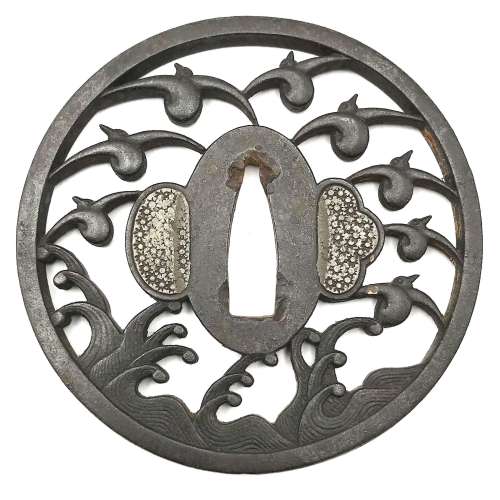
Iron tsuba of circular form with the knotted geese (kari) flying over the rough waves pierced (sukashi) and carved in low relief (nikubori). Hitsu-ana plugged with soft metal. Hitsu-ana plugged with soft metal (tin or lead).
Signed: Echizen koku jū Myochin Katsuharu saku.
Edo period.Size: Height: 80.7 mm; Width: 81.0 mm; Thickness: 4.5 mm; Weight: 110 g.
Two tsuba of this master can be found at Georg Oeder Collection (Japanische Stichblätter und Schwertzieraten. Sammlung Georg Oeder Düsseldorf. Beschreibendes Verzeichnis von P. Vautier. Herausgegeben von Otto Kümmel.Oesterheld & Co / Verlag / Berlin, Oesterheld, 1915; LIB-1465 in this collection) under №№ 172 and 173, page 21, though no illustrations. SOLD. -
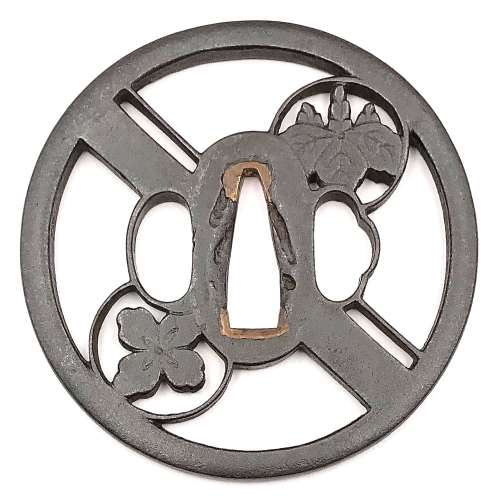 Iron tsuba of round form with design of double crossbar and two family crests (hikiryo-ni-kamon) in openwork (sukashi). Squared rim. Copper sekigane. Owari school. Early Edo period: Late 17th century (Kanbun / Enppo era). Height: 80.9 mm. Width: 80.8 mm. Rim thickness: 5.0 mm. Center thickness: 4.6 mm. Provenance: Sasano Masayuki Collection, № 172: "A paulownia and a clover are diagonally opposite two crossbars. This expressive design suggests a Higo origin, but the iron and the finish are certainly of the Owari school. Work of this nature may have been influenced by Hayashi Matashichi (1613-1699)."
Iron tsuba of round form with design of double crossbar and two family crests (hikiryo-ni-kamon) in openwork (sukashi). Squared rim. Copper sekigane. Owari school. Early Edo period: Late 17th century (Kanbun / Enppo era). Height: 80.9 mm. Width: 80.8 mm. Rim thickness: 5.0 mm. Center thickness: 4.6 mm. Provenance: Sasano Masayuki Collection, № 172: "A paulownia and a clover are diagonally opposite two crossbars. This expressive design suggests a Higo origin, but the iron and the finish are certainly of the Owari school. Work of this nature may have been influenced by Hayashi Matashichi (1613-1699)." -
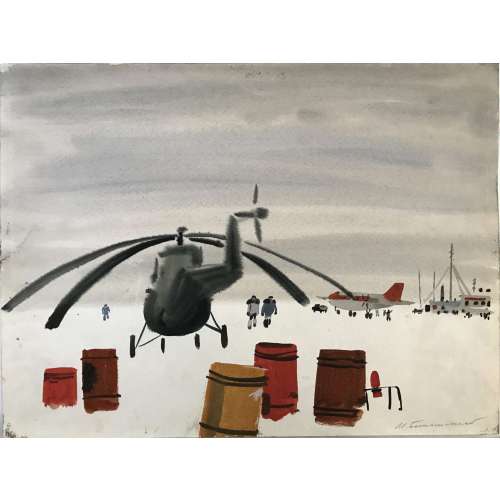 Mikhail Belomlinsky. Born 1934, Russia. Helicopter. Watercolor painting on paper from Chukotka expedition, 1975. Size: 36 x 48 cm.
Mikhail Belomlinsky. Born 1934, Russia. Helicopter. Watercolor painting on paper from Chukotka expedition, 1975. Size: 36 x 48 cm. -
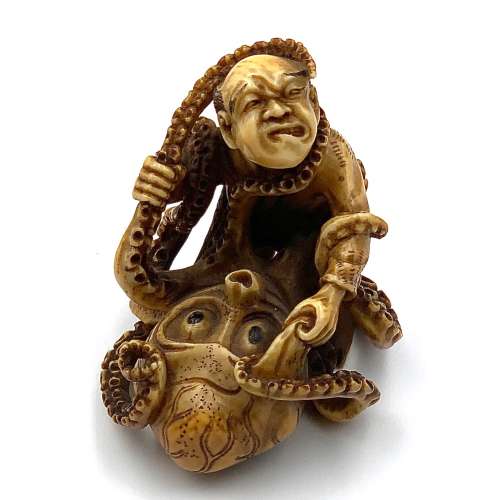
Ivory netsuke with a design of a man (possibly - Ariōmaru) wrestling a giant octopus.
Circa 1850. Dimensions: 45.5 x 48.3 x 37.8 mmUnsigned.


